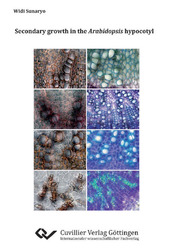| Areas | |
|---|---|
| Serie de libros (96) |
1378
|
| Nachhaltigkeit |
3
|
| Gesundheitswesen |
1
|
| Letra |
2363
|
| Ciencias Naturales |
5406
|
| Matemática | 229 |
| Informática | 319 |
| Física | 980 |
| Química | 1363 |
| Geociencias | 131 |
| Medicina humana | 243 |
| Estomatología | 10 |
| Veterinaria | 108 |
| Farmacia | 147 |
| Biología | 835 |
| Bioquímica, biología molecular, tecnología genética | 121 |
| Biofísica | 25 |
| Nutrición | 45 |
| Agricultura | 1004 |
| Silvicultura | 201 |
| Horticultura | 20 |
| Ecología y conservación de la tierra | 148 |
| Ciencias Ingeniería |
1791
|
| General |
98
|
|
Leitlinien Unfallchirurgie
5. Auflage bestellen |
|
Erweiterte Suche
Secondary growth in the Arabidopsis hypocotyl (Tienda española)
Widi Sunaryo (Autor)Previo
Indice, Datei (42 KB)
Lectura de prueba, Datei (150 KB)
Secondary growth results from cell division and differentiation in the vascular cambium and gives rise to secondary xylem and phloem. Xylem of trees, commonly referred to as wood, is an important carbon source used for woody materials and industrial purposes such as timber, pulp, furniture, fibers, and also as a energy source. Although abundant data has been collected to address the genetic control of cambial activity and differentiation, the mechanism behind is still little known. The Arabidopsis hypocotyl has previously been shown to be a suitable model for secondary growth and xylem differentiation similar as it occurs in angiosperm trees.
Plant development requires a tightly controlled balance between undifferentiated dividing cells and cells, which are subjected to undergo differentiation. In the shoot apical meristem of Arabidopsis, this process is governed by a complex signaling network involving several classes of transcription factors, which are often expressed in highly distinct patterns. Key-players of differentiation control are the KNOX genes (Knotted-1 like genes; e.g. KNAT1, KNAT2, STM), which comprise a small gene family with eight members in Arabidopsis thaliana. This project was aimed to investigate the role of KNOX genes in secondary growth and differentiation of xylem using the Arabidopsis hypocotyl as a model.
T-DNA insertion mutants for all Arabidopsis KNOX genes were isolated. Mutants of stm and knat1 showed reduced xylem diameter and xylem fiber formation. The double mutant stm-GK;knat1bp-9 had a strongly enhanced phenotype. STM and KNAT1 were expressed in the cambial zone and their expression was not dependent on each other. Taken together this shows that STM and KNAT1 have overlapping function and act synergistically on cambial activity and differentiation of xylem derivates.
Neither constitutive nor inducible overexpression of KNAT1 led to overproduction of xylem. Moreover, overexpression of KNAT1 could not complement the effects of stm-GK on xylem formation. This points to a requirement of optimal concentration for both genes, as it is often observed for physically interacting proteins.
KNAT1 and STM function are required for ATHB-8 expression, a marker of early vascularization, in early xylem fiber derivates. CyclinB1;1::GUS, a cell divison reporter, showed that parenchymatic cells, which occurred instead of xylem fibers are no longer mitotically active. Hence, they are blocked in an early step of differentiation.
| ISBN-10 (Impresion) | 3869555882 |
| ISBN-13 (Impresion) | 9783869555881 |
| ISBN-13 (E-Book) | 9783736935884 |
| Idioma | Inglés |
| Numero de paginas | 130 |
| Edicion | 1 Aufl. |
| Volumen | 0 |
| Lugar de publicacion | Göttingen |
| Lugar de la disertacion | Universität Göttingen |
| Fecha de publicacion | 09.12.2010 |
| Clasificacion simple | Tesis doctoral |
| Area |
Biología
Bioquímica, biología molecular, tecnología genética |








